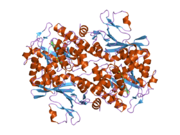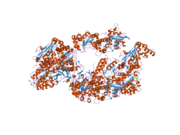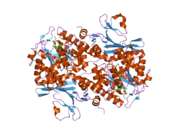Biology:Nicotinamide phosphoribosyltransferase
 Generic protein structure example |
| nicotinamide phosphoribosyltransferase | |||||||||
|---|---|---|---|---|---|---|---|---|---|
| Identifiers | |||||||||
| EC number | 2.4.2.12 | ||||||||
| CAS number | 9030-27-7 | ||||||||
| Databases | |||||||||
| IntEnz | IntEnz view | ||||||||
| BRENDA | BRENDA entry | ||||||||
| ExPASy | NiceZyme view | ||||||||
| KEGG | KEGG entry | ||||||||
| MetaCyc | metabolic pathway | ||||||||
| PRIAM | profile | ||||||||
| PDB structures | RCSB PDB PDBe PDBsum | ||||||||
| Gene Ontology | AmiGO / QuickGO | ||||||||
| |||||||||
Nicotinamide phosphoribosyltransferase (NAmPRTase or NAMPT), formerly known as pre-B-cell colony-enhancing factor 1 (PBEF1) or visfatin for its extracellular form (eNAMPT),[1] is an enzyme that in humans is encoded by the NAMPT gene.[2] The intracellular form of this protein (iNAMPT) is the rate-limiting enzyme in the nicotinamide adenine dinucleotide (NAD+) salvage pathway that converts nicotinamide to nicotinamide mononucleotide (NMN) which is responsible for most of the NAD+ formation in mammals.[3] iNAMPT can also catalyze the synthesis of NMN from phosphoribosyl pyrophosphate (PRPP) when ATP is present.[4] eNAMPT has been reported to be a cytokine (PBEF) that activates TLR4,[5] that promotes B cell maturation, and that inhibits neutrophil apoptosis.
Reaction
iNAMPT catalyzes the following chemical reaction:
- nicotinamide + 5-phosphoribosyl-1-pyrophosphate (PRPP) [math]\displaystyle{ \rightleftharpoons }[/math] nicotinamide mononucleotide (NMN) + pyrophosphate (PPi)
Thus, the two substrates of this enzyme are nicotinamide and 5-phosphoribosyl-1-pyrophosphate (PRRP), whereas its two products are nicotinamide mononucleotide and pyrophosphate.[3]
This enzyme belongs to the family of glycosyltransferases, to be specific, the pentosyltransferases. This enzyme participates in nicotinate and nicotinamide metabolism.
Expression and regulation
The liver has the highest iNAMPT activity of any organ, about 10-20 times greater activity than kidney, spleen, heart, muscle, brain or lung.[6] iNAMPT is downregulated by an increase of miR-34a in obesity via a 3'UTR functional binding site of iNAMPT mRNA resulting in a reduction of NAD(+) and decreased SIRT1 activity.[7]
Endurance-trained athletes have twice the expression of iNAMPT in skeletal muscle compared with sedentary type 2 diabetic persons.[8] In a six-week study comparing legs trained by endurance exercise with untrained legs, iNAMPT was increased in the endurance-trained legs.[8] A study of 21 young (under 36) and 22 old (over 54) adults subject to 12 weeks of aerobic and resistance exercise showed aerobic exercise to increase skeletal muscle iNAMPT 12% and 28% in young and old (respectively) and resistance exercise to increase skeletal muscle iNAMPT 25% and 30% in young and old (respectively).[9]
Aging, obesity, and chronic inflammation all reduce iNAMPT (and consequently NAD+) in multiple tissues,[10] and NAMPT activity was shown to promote a proinflammatory transcriptional reprogramming of immune cells (e.g. macrophages[11]) and brain-resident astrocytes.[12]
Function
iNAMPT catalyzes the condensation of nicotinamide (NAM) with 5-phosphoribosyl-1-pyrophosphate to yield nicotinamide mononucleotide (NMN), the first step in the biosynthesis of nicotinamide adenine dinucleotide (NAD+).[13] This salvage pathway, reusing NAM from enzymes using NAD+ (sirtuins, PARPs, CD38) and producing NAM as a waste product, is the major source of NAD+ production in the body.[13] De novo synthesis of NAD+ from tryptophan occurs only in the liver and kidney, overwhelmingly in the liver.[13]
Nomenclature
The systematic name of this enzyme class is nicotinamide-nucleotide:diphosphate phospho-alpha-D-ribosyltransferase. Other names in common use include:
- NMN pyrophosphorylase,
- nicotinamide mononucleotide pyrophosphorylase,
- nicotinamide mononucleotide synthetase, and
- NMN synthetase.
Extracellular NAMPT
Extracellular NAMPT (eNAMPT) is functionally different from intracellular NAMPT (iNAMPT), and less well understood (which is why the enzyme has been given so many names: NAMPT, PBEF and visfatin).[1] iNAMPT is secreted by many cell types (nobably adipocytes) to become eNAMPT. The sirtuin 1 (SIRT1) enzyme is required for eNAMPT secretion from adipose tissue.[14] eNAMPT may act more as a cytokine, although its receptor (possibly TLR4) has not been proven.[4] It has been demonstrated that eNAMPT could bind to and activate TLR4.[15]
eNAMPT can exist as a dimer or as a monomer, but is normally a circulating dimer.[14] As a monomer, eNAMPT has pro-inflammatory effects that are independent of NAD+, whereas the dimeric form of eNAMPT protects against these effects.[14]
eNAMPT/PBEF/visfatin was originally cloned as a putative cytokine shown to enhance the maturation of B cell precursors in the presence of Interleukin-7 (IL-7) and stem cell factor, it was therefore named "pre-B cell colony-enhancing factor" (PBEF).[2] When the gene encoding the bacterial nicotinamide phosphoribosyltransferase (nadV) was first isolated in Haemophilus ducreyi, it was found to exhibit significant homology to the mammalian PBEF gene.[16] Rongvaux et al.[17] demonstrated genetically that the mouse PBEF gene conferred Nampt enzymatic activity and NAD-independent growth to bacteria lacking nadV. Revollo et al.[18] determined biochemically that the mouse PBEF gene product encodes an eNAMPT enzyme, capable of modulating intracellular NAD levels. Others have since confirmed these findings.[19] More recently, several groups have reported the crystal structure of Nampt/PBEF/visfatin and they all show that this protein is a dimeric type II phosphoribosyltransferase enzyme involved in NAD biosynthesis.[20][21][22]
eNAMPT has been shown to be more enzymatically active than iNAMPT, supporting the proposal that eNAMPT from adipose tissue enhances NAD+ in tissues with low levels of iNAMPT, notably pancreatic beta cells and brain neurons.[23]
Hormone claim retracted
Although the original cytokine function of PBEF has not been confirmed to date, others have since reported or suggested a cytokine-like function for this protein.[24] In particular, Nampt/PBEF was recently re-identified as a "new visceral fat-derived hormone" named visfatin.[25] It is reported that visfatin is enriched in the visceral fat of both humans and mice and that its plasma levels increase during the development of obesity.[25] Noteworthy is that visfatin is reported to exert insulin-mimetic effects in cultured cells and to lower plasma glucose levels in mice by binding to and activating the insulin receptor.[25] However, the physiological relevance of visfatin is still in question because its plasma concentration is 40 to 100-fold lower than that of insulin despite having similar receptor-binding affinity.[25][26][27] In addition, the ability of visfatin to bind and activate the insulin-receptor has yet to be confirmed by other groups.
On 26 October 2007, A. Fukuhara (first author), I.Shimomura (senior author) and the other co-authors of the paper,[25] who first described Visfatin as a visceral-fat derived hormone that acts by binding and activating the insulin receptor, retracted the entire paper[25] at the suggestion of the editor of the journal 'Science' and recommendation of the Faculty Council of Osaka University Medical School after a report of the Committee for Research Integrity.[28]
As a drug target
Because cancer cells utilize increased glycolysis, and because NAD enhances glycolysis, iNAMPT is often amplified in cancer cells.[29][30] APO866 is an experimental drug that inhibits this enzyme.[31] It is being tested for treatment of advanced melanoma, cutaneous T-cell lymphoma (CTL), and refractory or relapsed B-chronic lymphocytic leukemia.
The NAMPT inhibitor FK866 has been shown to inhibit epithelial–mesenchymal transition (EMT), and may also inhibit tumor-associated angiogenesis.[5]
Anti-aging biomedical company Calico has licensed the experimental P7C3 analogs involved in enhancing iNAMPT activity.[32] P7C3 compounds have been shown in a number of publications to be beneficial in animal models for age-related neurodegeneration.[33][34]
References
- ↑ 1.0 1.1 "Extracellular nicotinamide phosphoribosyltransferase, a new cancer metabokine". British Journal of Pharmacology 173 (14): 2182–2194. July 2016. doi:10.1111/bph.13505. PMID 27128025.
- ↑ 2.0 2.1 "Cloning and characterization of the cDNA encoding a novel human pre-B-cell colony-enhancing factor". Molecular and Cellular Biology 14 (2): 1431–1437. February 1994. doi:10.1128/MCB.14.2.1431. PMID 8289818.
- ↑ 3.0 3.1 "The regulation of nicotinamide adenine dinucleotide biosynthesis by Nampt/PBEF/visfatin in mammals". Current Opinion in Gastroenterology 23 (2): 164–170. March 2007. doi:10.1097/MOG.0b013e32801b3c8f. PMID 17268245.
- ↑ 4.0 4.1 "Recent Advances in NAMPT Inhibitors: A Novel Immunotherapic Strategy". Frontiers in Pharmacology 11: 656. 2020. doi:10.3389/fphar.2020.00656. PMID 32477131.
- ↑ 5.0 5.1 "Recent Advances in NAMPT Inhibitors: A Novel Immunotherapic Strategy". Frontiers in Pharmacology 11: 656. 2020. doi:10.3389/fphar.2020.00656. PMID 32477131.
- ↑ "Nicotinamide is an inhibitor of SIRT1 in vitro, but can be a stimulator in cells". Cellular and Molecular Life Sciences 74 (18): 3347–3362. September 2017. doi:10.1007/s00018-017-2527-8. PMID 28417163.
- ↑ "Elevated microRNA-34a in obesity reduces NAD+ levels and SIRT1 activity by directly targeting NAMPT". Aging Cell 12 (6): 1062–1072. December 2013. doi:10.1111/acel.12135. PMID 23834033.
- ↑ 8.0 8.1 "Implications of NAD+ Metabolism in the Aging Retina and Retinal Degeneration". Oxidative Medicine and Cellular Longevity 2020: 2692794. 2020. doi:10.1155/2020/2692794. PMID 32454935.
- ↑ "Aerobic and resistance exercise training reverses age-dependent decline in NAD+ salvage capacity in human skeletal muscle". Physiological Reports 7 (12): e14139. July 2019. doi:10.14814/phy2.14139. PMID 31207144.
- ↑ "NAMPT-Mediated NAD Biosynthesis as the Internal Timing Mechanism: In NAD+ World, Time Is Running in Its Own Way". Rejuvenation Research 21 (3): 210–224. June 2018. doi:10.1089/rej.2017.1975. PMID 28756747.
- ↑ "Inflammatory macrophage dependence on NAD+ salvage is a consequence of reactive oxygen species-mediated DNA damage". Nature Immunology 20 (4): 420–432. April 2019. doi:10.1038/s41590-019-0336-y. PMID 30858618.
- ↑ "NAD+ metabolism drives astrocyte proinflammatory reprogramming in central nervous system autoimmunity". Proceedings of the National Academy of Sciences of the United States of America 119 (35): e2211310119. August 2022. doi:10.1073/pnas.2211310119. PMID 35994674. Bibcode: 2022PNAS..11911310M.
- ↑ 13.0 13.1 13.2 "Quantitative Analysis of NAD Synthesis-Breakdown Fluxes". Cell Metabolism 27 (5): 1067–1080.e5. May 2018. doi:10.1016/j.cmet.2018.03.018. PMID 29685734.
- ↑ 14.0 14.1 14.2 "NAD+ Intermediates: The Biology and Therapeutic Potential of NMN and NR". Cell Metabolism 27 (3): 513–528. March 2018. doi:10.1016/j.cmet.2017.11.002. PMID 29249689.
- ↑ "Unique Toll-Like Receptor 4 Activation by NAMPT/PBEF Induces NFκB Signaling and Inflammatory Lung Injury". Scientific Reports 5: 13135. August 2015. doi:10.1038/srep13135. PMID 26272519. Bibcode: 2015NatSR...513135C.
- ↑ "Identification of a plasmid-encoded gene from Haemophilus ducreyi which confers NAD independence". Journal of Bacteriology 183 (4): 1168–1174. February 2001. doi:10.1128/JB.183.4.1168-1174.2001. PMID 11157928.
- ↑ "Pre-B-cell colony-enhancing factor, whose expression is up-regulated in activated lymphocytes, is a nicotinamide phosphoribosyltransferase, a cytosolic enzyme involved in NAD biosynthesis". European Journal of Immunology 32 (11): 3225–3234. November 2002. doi:10.1002/1521-4141(200211)32:11<3225::AID-IMMU3225>3.0.CO;2-L. PMID 12555668.
- ↑ "The NAD biosynthesis pathway mediated by nicotinamide phosphoribosyltransferase regulates Sir2 activity in mammalian cells". The Journal of Biological Chemistry 279 (49): 50754–50763. December 2004. doi:10.1074/jbc.M408388200. PMID 15381699.
- ↑ "Pre-B-cell colony-enhancing factor regulates NAD+-dependent protein deacetylase activity and promotes vascular smooth muscle cell maturation". Circulation Research 97 (1): 25–34. July 2005. doi:10.1161/01.RES.0000173298.38808.27. PMID 15947248.
- ↑ "Structure of Nampt/PBEF/visfatin, a mammalian NAD+ biosynthetic enzyme". Nature Structural & Molecular Biology 13 (7): 661–662. July 2006. doi:10.1038/nsmb1114. PMID 16783373.
- ↑ "Crystal structure of visfatin/pre-B cell colony-enhancing factor 1/nicotinamide phosphoribosyltransferase, free and in complex with the anti-cancer agent FK-866". Journal of Molecular Biology 362 (1): 66–77. September 2006. doi:10.1016/j.jmb.2006.06.082. PMID 16901503.
- ↑ "Molecular basis for the inhibition of human NMPRTase, a novel target for anticancer agents". Nature Structural & Molecular Biology 13 (7): 582–588. July 2006. doi:10.1038/nsmb1105. PMID 16783377.
- ↑ "The NAD World 2.0: the importance of the inter-tissue communication mediated by NAMPT/NAD+/SIRT1 in mammalian aging and longevity control". npj Systems Biology and Applications 2: 16018. 2016. doi:10.1038/npjsba.2016.18. PMID 28725474.
- ↑ "Pre-B cell colony-enhancing factor inhibits neutrophil apoptosis in experimental inflammation and clinical sepsis". The Journal of Clinical Investigation 113 (9): 1318–1327. May 2004. doi:10.1172/JCI19930. PMID 15124023.
- ↑ 25.0 25.1 25.2 25.3 25.4 25.5 "Visfatin: a protein secreted by visceral fat that mimics the effects of insulin". Science 307 (5708): 426–430. January 2005. doi:10.1126/science.1097243. PMID 15604363. Bibcode: 2005Sci...307..426F. (Retracted, see PMID 17962537)
- ↑ "An update on visfatin/pre-B cell colony-enhancing factor, an ubiquitously expressed, illusive cytokine that is regulated in obesity". Current Opinion in Lipidology 17 (2): 128–131. April 2006. doi:10.1097/01.mol.0000217893.77746.4b. PMID 16531748.
- ↑ "Visfatin--a true or false trail to type 2 diabetes mellitus". The Journal of Clinical Endocrinology and Metabolism 91 (1): 28–30. January 2006. doi:10.1210/jc.2005-2391. PMID 16401830.
- ↑ "Retraction". Science 318 (5850): 565. October 2007. doi:10.1126/science.318.5850.565b. PMID 17962537.
- ↑ "NAD Metabolism in Cancer Therapeutics". Frontiers in Oncology 8: 622. 2018. doi:10.3389/fonc.2018.00622. PMID 30631755.
- ↑ "NAD- and NADPH-Contributing Enzymes as Therapeutic Targets in Cancer: An Overview". Biomolecules 10 (3): 358. February 2020. doi:10.3390/biom10030358. PMID 32111066.
- ↑ APO866 Not Effective for Cutaneous T-Cell Lymphoma. March 2016
- ↑ "UT Southwestern researchers discover novel class of NAMPT activators for neurodegenerative disease; Calico enters into exclusive collaboration with 2M to develop UTSW technology" (Press release).
- ↑ "NAMPT neuroprotection". Science-Business EXchange 7 (38): 1112. 2014. doi:10.1038/scibx.2014.1112.
- ↑ "P7C3 neuroprotective chemicals function by activating the rate-limiting enzyme in NAD salvage". Cell 158 (6): 1324–1334. September 2014. doi:10.1016/j.cell.2014.07.040. PMID 25215490.
Further reading
- "Enzymatic synthesis of nicotinamide mononucleotide". The Journal of Biological Chemistry 225 (2): 759–770. April 1957. doi:10.1016/S0021-9258(18)64875-6. PMID 13416279.
- "An update on visfatin/pre-B cell colony-enhancing factor, an ubiquitously expressed, illusive cytokine that is regulated in obesity". Current Opinion in Lipidology 17 (2): 128–131. April 2006. doi:10.1097/01.mol.0000217893.77746.4b. PMID 16531748.
- "Apelin and visfatin: unique "beneficial" adipokines upregulated in obesity?". Medical Science Monitor 12 (6): RA112–RA119. June 2006. PMID 16733497.
- "Visfatin/pre-B-cell colony-enhancing factor: a protein with various suggested functions". Journal of Endocrinological Investigation 30 (2): 138–144. February 2007. doi:10.1007/bf03347412. PMID 17392604.
- "A set of human putative lymphocyte G0/G1 switch genes includes genes homologous to rodent cytokine and zinc finger protein-encoding genes". DNA and Cell Biology 9 (8): 579–587. October 1990. doi:10.1089/dna.1990.9.579. PMID 1702972.
- Sanger Centre, The; Washington University Genome Sequencing Cente, The (November 1998). "Toward a complete human genome sequence". Genome Research 8 (11): 1097–1108. doi:10.1101/gr.8.11.1097. PMID 9847074.
- "Pre-B-cell colony-enhancing factor, whose expression is up-regulated in activated lymphocytes, is a nicotinamide phosphoribosyltransferase, a cytosolic enzyme involved in NAD biosynthesis". European Journal of Immunology 32 (11): 3225–3234. November 2002. doi:10.1002/1521-4141(200211)32:11<3225::AID-IMMU3225>3.0.CO;2-L. PMID 12555668.
- "Growth phase-dependent changes in the subcellular localization of pre-B-cell colony-enhancing factor". FEBS Letters 544 (1–3): 74–78. June 2003. doi:10.1016/S0014-5793(03)00476-9. PMID 12782293.
- "Yeast two-hybrid screens imply involvement of Fanconi anemia proteins in transcription regulation, cell signaling, oxidative metabolism, and cellular transport". Experimental Cell Research 289 (2): 211–221. October 2003. doi:10.1016/S0014-4827(03)00261-1. PMID 14499622.
- "Pre-B cell colony-enhancing factor inhibits neutrophil apoptosis in experimental inflammation and clinical sepsis". The Journal of Clinical Investigation 113 (9): 1318–1327. May 2004. doi:10.1172/JCI19930. PMID 15124023.
- "Immunoaffinity profiling of tyrosine phosphorylation in cancer cells". Nature Biotechnology 23 (1): 94–101. January 2005. doi:10.1038/nbt1046. PMID 15592455.
- "Identification of genes potentially involved in disease transformation of CML". Leukemia 19 (6): 998–1004. June 2005. doi:10.1038/sj.leu.2403735. PMID 15815727.
- "Pre-B-cell colony-enhancing factor regulates NAD+-dependent protein deacetylase activity and promotes vascular smooth muscle cell maturation". Circulation Research 97 (1): 25–34. July 2005. doi:10.1161/01.RES.0000173298.38808.27. PMID 15947248.
- "Pre-B-cell colony-enhancing factor is a secreted cytokine-like protein from the human amniotic epithelium". American Journal of Obstetrics and Gynecology 193 (1): 273–282. July 2005. doi:10.1016/j.ajog.2004.11.003. PMID 16021090.
External links
- visfatin,+human at the US National Library of Medicine Medical Subject Headings (MeSH)
- NAMPT human gene location in the UCSC Genome Browser.
- NAMPT human gene details in the UCSC Genome Browser.
- Overview of all the structural information available in the PDB for UniProt: P43490 (Human Nicotinamide phosphoribosyltransferase) at the PDBe-KB.
- Overview of all the structural information available in the PDB for UniProt: Q99KQ4 (Mouse Nicotinamide phosphoribosyltransferase) at the PDBe-KB.
 |









